Menus
- Track test super athletes under 1000 cm³
- Suzuki GSX-R 750 – the underrated
- MV Agusta F3 800 – the passionate one
- Ducati 959 Panigale – the unspectacular
- Measured values and lap times
- Lap times
- Technical specifications
- Conclusion
- Dunlop D212 GP Pro
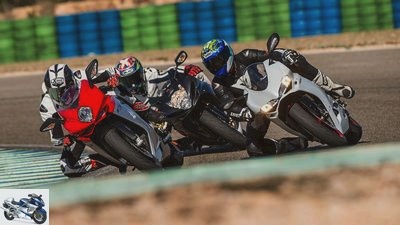
Arturo Rivas
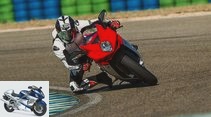
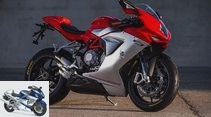
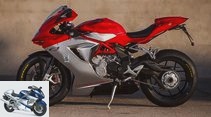
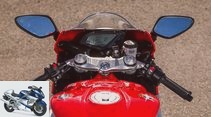
40 photos
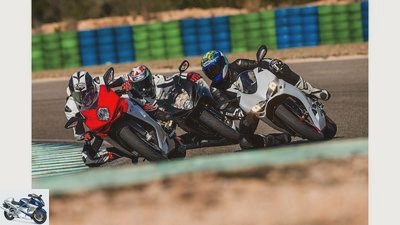
Arturo Rivas
1/40
The super sports cars Ducati 959 Panigale, MV Agusta F3 800 and Suzuki GSX-R 750.

Arturo Rivas
2/40
MV Agusta F3 800.

Arturo Rivas
3/40
MV Agusta F3 800.
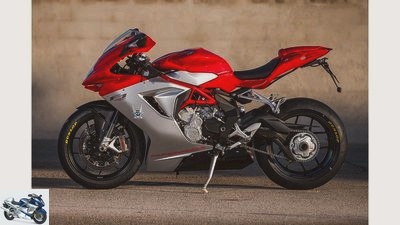
Arturo Rivas
4/40
MV Agusta F3 800.

Arturo Rivas
5/40
Asymmetrical fork with rebound and compression damping in one spar. The mirrors are not adjustable.
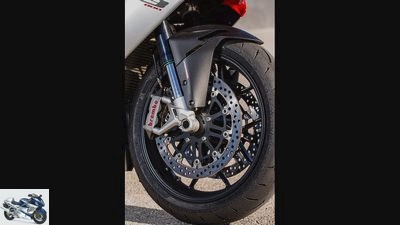
Arturo Rivas
6/40
MV Agusta F3 800.
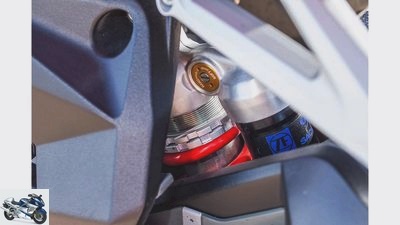
Arturo Rivas
7/40
The Sachs shock absorber does its job very well, but needs a wide compression damping.

Arturo Rivas
8/40
Commendable: standard automatic gearshift, but without a blipper function.
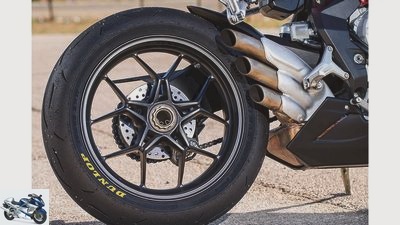
Arturo Rivas
9/40
MV Agusta F3 800.
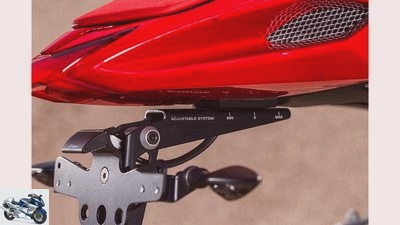
Arturo Rivas
10/40
MV Agusta F3 800.
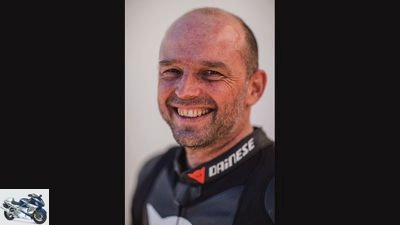
Arturo Rivas
11/40
Volkmar Jacob, author: “The MV offers both: passion and speed. Only the TC does not work properly “.
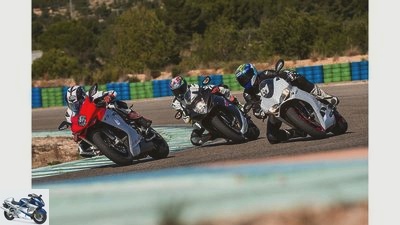
Arturo Rivas
12/40
The super sports cars Ducati 959 Panigale, MV Agusta F3 800 and Suzuki GSX-R 750.

Arturo Rivas
13/40
Get along very well: track manager Louis and the author after a previous wheelie discussion.
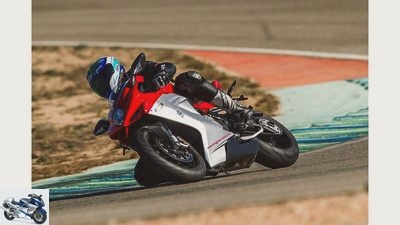
Arturo Rivas
14/40
Handling and accuracy are among the F3’s favorite disciplines. Burning with her leaves no one indifferent.
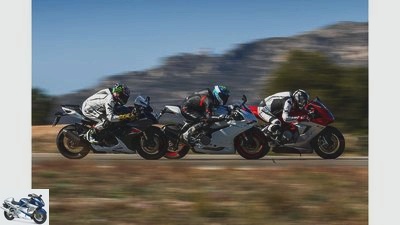
Arturo Rivas
15/40
The slope in Calafat in northern Spain is perfect for this performance class. Shooting in close formation sharpens the senses.
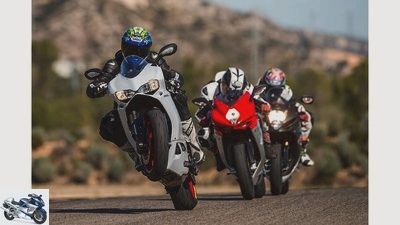
Arturo Rivas
16/40
The super sports cars Ducati 959 Panigale, MV Agusta F3 800 and Suzuki GSX-R 750.
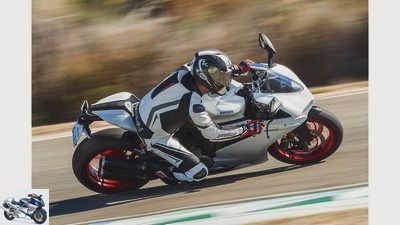
Arturo Rivas
17/40
The stability of the Duc in all positions turns on. It creates trust and automatically increases the speed.
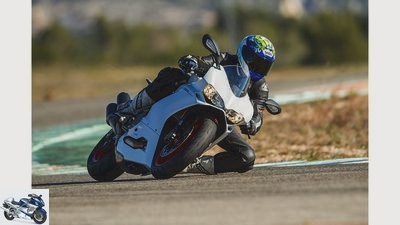
Arturo Rivas
18/40
Ducati 959 Panigale.
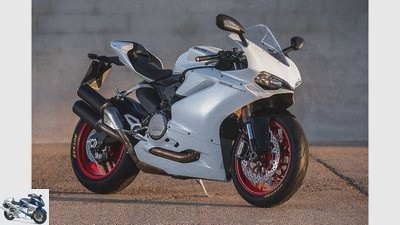
Arturo Rivas
19/40
Ducati 959 Panigale.
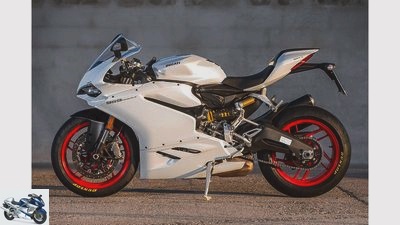
Arturo Rivas
20/40
Ducati 959 Panigale.
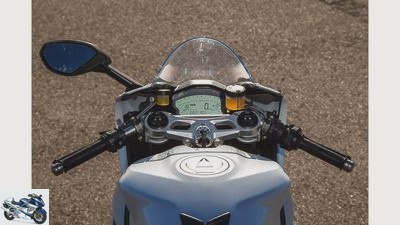
Arturo Rivas
21/40
The cockpit offers an extensive menu and enables freely configurable driving modes.
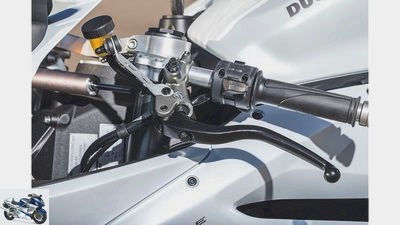
Arturo Rivas
22/40
Ducati 959 Panigale.
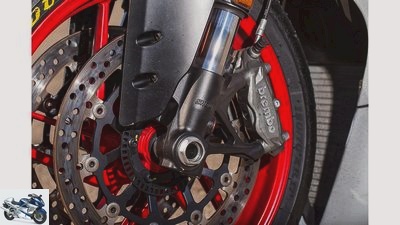
Arturo Rivas
23/40
Ducati 959 Panigale.

Arturo Rivas
24/40
Ducati 959 Panigale.

Arturo Rivas
25/40
Ducati 959 Panigale.
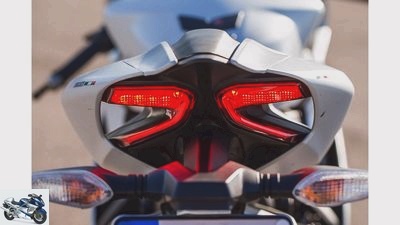
Arturo Rivas
26/40
When it comes to styling, nobody can fool the Italians so quickly. The rear end is a real feast for the eyes.

Arturo Rivas
27/40
Sven Loll, HP permanent auxiliary drifter: “The Ducati is faster than it feels. That’s what makes a good bike “.
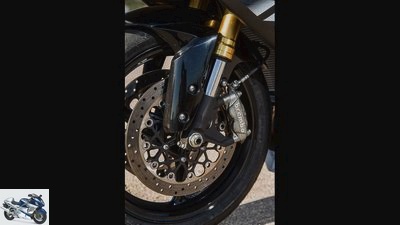
Arturo Rivas
28/40
Suzuki GSX-R 750.
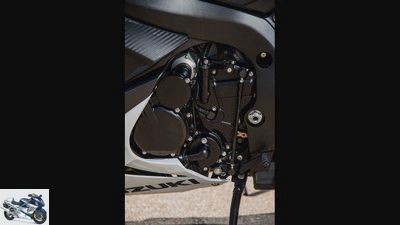
Arturo Rivas
29/40
Suzuki GSX-R 750.
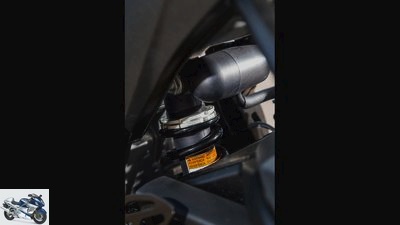
Arturo Rivas
30/40
Suzuki GSX-R 750.

Arturo Rivas
31/40
Suzuki GSX-R 750.
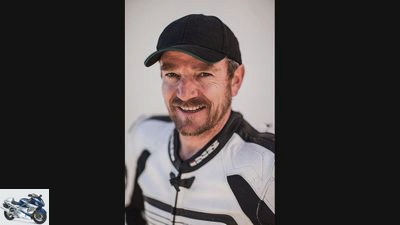
Arturo Rivas
32/40
Achim Steinmacher, guest starter: “I don’t need electronic driving aids. Therefore, Suzi suits me very well “.
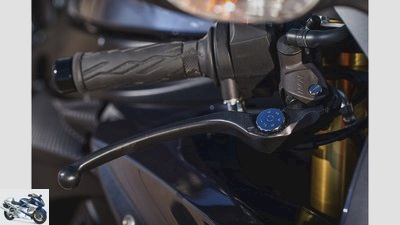
Arturo Rivas
33/40

Arturo Rivas
34/40
Suzuki GSX-R 750.
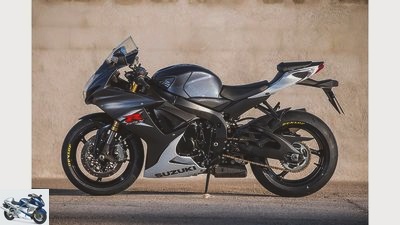
Arturo Rivas
35/40
Suzuki GSX-R 750.
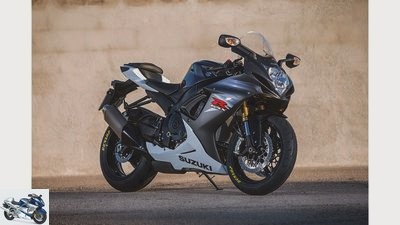
Arturo Rivas
36/40
Suzuki GSX-R 750.
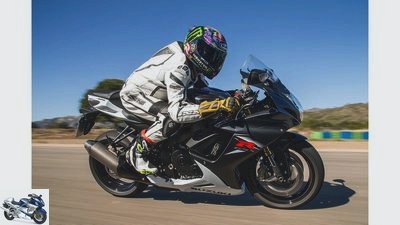
Arturo Rivas
37/40
Suzuki GSX-R 750.

Arturo Rivas
38/40
Suzuki GSX-R 750.
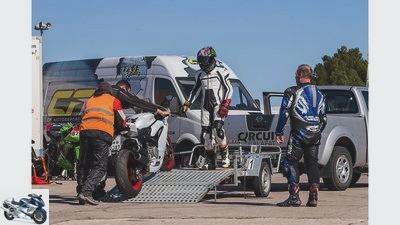
Arturo Rivas
39/40
The super sports cars Ducati 959 Panigale, MV Agusta F3 800 and Suzuki GSX-R 750.
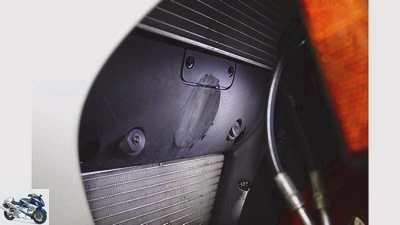
Yvonne Hertler
40/40
Shouldn’t happen: When braking hard, the front wheel hits the radiator cowling. Further damage cannot be ruled out.
Ducati 959 Panigale, MV Agusta F3 800 and Suzuki GSX-R 750 in the test
Track test super athletes under 1000 cm³
Content of
With the new Ducati 959 Panigale, the class between 750 and 1000 cubic meters is getting a new boost. Shootout with MV Agusta F3 800 and Suzuki GSX-R 750 on the Calafat race track.
The black flag comes after a few rounds. “No wheelies!” Warns track manager Louis with a serious expression. The small, friendly Spaniard belongs to the slopes of Calafat like the Pope to the Vatican. No event, no trackday without him. Now he makes it clear: “Short acceleration wheelies from corners are okay. But over the whole back straight – no posible! ”It’s a shame, because the Ducati climbed one lap earlier 959 Panigale out of the Omega relishly onto the rear wheel and held this position in a perfectly controllable manner until the braking point of the paddock chicane. But because we don’t want to mess it up with Louis, we are foregoing such deposits with immediate effect.
Buy complete article
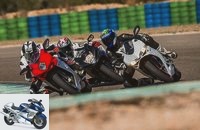
Ducati 959 Panigale, MV Agusta F3 800 and Suzuki GSX-R 750 in the test
Track test super athletes under 1000 cm³
MV Agusta F3 800 armed, investigates the question: Which bike fires around the slopes and how fast? Former long-distance World Championship pilot Achim “Steini” Steinmacher and PS permanent auxiliary drifter Sven “Lolle” Loll pull the cable with the author.
Even rolling it up is a real treat for the ears. The sound carpet from the dull two-cylinder rumble of the Panigale, the poisonous hissing of the MV triples and the hotter screams of the Suzuki quadruple hits the nerve center. Despite their different engine concepts and displacements, the trio have one thing in common: their nominal power is around 150 hp. After we’ve made a few turns, things get serious. One after the other, we climb on Ducati 959 Panigale, MV Agusta F3 800 and Suzuki GSX-R 750 and squeeze everything out of us and the sports bikes.
Suzuki GSX-R 750 – the underrated
As the senior, the Suzuki GSX-R 750 makes the start. The last technical renovation for the model year 2012, it could be easy prey for modern competition. Electronic driving aids such as ABS or traction control are nil, and the engine, with a measured 138 hp, sends twelve fewer ponies into the race than promised. With the narrowest handlebars and the greatest distance between seat and handlebar height, it also places your jockey much more passively than the Ducati 959 Panigale and MV Agusta F3 800.
Arturo Rivas
Suzuki GSX-R 750: lap time 1.35.1 min (+0.1 sec.)
Nevertheless, the Suzuki GSX-R 750 has its qualities. The four-cylinder marches around like hell and drives speed-hungry pilots still tears of joy in the eyes. In addition, it forms a magnificent performance plateau between 12,000 rpm and 14,000 rpm. In the four-digit range, however, only a mild breeze blows, which slows down the load in Calafat with its many slow corners. In the first gear the Gixxe tears there too aggressively, in the second, however, it only comes out of the quark tough. On the other hand, the gearbox is great: the gear pairs slide into one another as if by themselves. Nevertheless, an automatic gearshift would look good on her.
The brakes also offer a great performance: firm bite, little hand strength, great transparency. Only the slightly shifting pressure point spoils two-finger brakes. Because after a few hard anchor throws, the lever moves close to the handlebars and meets the remaining fingers there. Otherwise the Suzuki GSX-R 750 is inconspicuous on the chassis side. It does not bend excessively, but with a very manageable amount of effort and obediently follows the required course. The shock absorber also offers a good average. In terms of response behavior, it does not create any sensitivity records, but the monoshock neatly filters out the grossest distortions on the sometimes very bumpy route. In hunting mode, however, the low-speed compression stage has to be closed almost completely. The fork is a highlight. She is very responsive and has great reserves.
As expected, guest pilot Steini is burning around the course as the fastest. 1.35.1 minutes are worth honoring in view of the fact that the basic form of the Suzuki GSX-R 750 has been in the showrooms for ages. The bottom line is that Ballern with the Gixxe resembles the principle of a long-term partnership: familiar and reliable, but without the tingling charm of the new.
MV Agusta F3 800 – the passionate one
The MV is completely different. It wasn’t until 2013 that Varese released the MV Agusta F3 800 on the people, so it is still very young in comparison. The Italians gave it ABS for 2014, and a year later it got an LED taillight and new colors. In the absence of a current test machine, we used a 2015 model from the Munich MV dealer Kawamotor. Thank you again for this! This model differs from the 2016 version only in the paintwork of the engine – from this year the drive will work in black.
Of course, this does not affect its inner values. Our test bench discovered 142 of the stated 148 hp. Fired up, the 800 series stormed away and cast a spell over the pilot. You just have to succumb to this fiery accession in combination with the greedy sound! Except for a range between 5,000 rpm and 7,000 rpm, which is insignificant for the race, the MV Agusta F3 800 delivers its punch powerfully and very evenly, the ideal gearshift speed is around 10,500 tours.
Arturo Rivas
MV Agusta F3 800: lap time 1.35.5 min (+0.5 sec.)
There is also praise for the throttle response. In sport mode (“S”), the MV Agusta F3 800 goes a little hard, but very directly on the gas – clearly the first choice for racing. On the other hand, the traction control has to be criticized once again. In the chicane in front of the sea bend, she often cuts off the spray supply when it is turned over, which severely slows down the load for a short time. At corner exits, on the other hand, it does not intervene, even on more sensitive levels, if an uncomfortable feeling arises when you power out. It is best to turn off the system completely.
The transmission provides light and shadow. Basically laudable: an automatic gearshift is on board as standard. However, the system has to get by without a blipper and can only conceal the switching processes, which are generally noticeable, with moderate success. Another point of criticism concerns the seating position. The tight space available on the MV Agusta F3 800 forces even normally grown pilots to sit back on the hump in the racing position.
One of the highlights of the MV Agusta F3 800 is clearly its chassis. A small impulse is all it takes, and whack, she whizzes through the corners. To do this, it hits the line exactly and, if necessary, can also be easily drawn to a narrower radius. That really puts you in the mood! The suspension elements work similarly to the Suzuki GSX-R 750: shock strut okay, fork great. But even the sensitive part cannot prevent the front from twitching briefly and seamlessly due to the lack of a steering damper. This mainly happens when turning under full load at the end of the right-hand bend onto the target entry left – a nasty, furrowed passage. Another noticeable feature of the F3 is the brutal anchoring and, at the same time, early downshifts. In this constellation, the stern suddenly gets off track and the load comes across. Countermeasure: only engage the appropriate gear shortly before the apex.
The brakes, however, do not require any special treatment. Effect and controllability are great, but your pressure point also shifts a bit. And? Lap time? 1.35.5 minutes. Contrary to the subjective feeling, the MV Agusta F3 800 loses a little time with four tenths on the Suzuki GSX-R 750. How one can be mistaken! But the timing with the incorruptible transponders speaks for itself. Can at least the second Italo bride, the Ducati 959 Panigale, save the honor of the boot country?
Ducati 959 Panigale – the unspectacular
There is much to be said for it. First of all, the Ducati 959 Panigale with 148 hp sends the most stallions into the arena. Thanks to the comparatively large displacement of its V2, it outperforms the competition in terms of torque. As a result, the Bologna bike often dashes up a gear and with an early and strongly cocked cock out of the corners. It’s unspectacular, but quick. This unexcited character runs like a red thread through the Panigale’s performance. Example curve sharpening: In this exercise, the 959 needs the most force, but is rock solid when tilted.
Arturo Rivas
Ducati 959 Panigale: lap time 1.35.0 min (best time)
Even when anchoring in the last groove, nothing disturbs the Ducati 959 Panigale – amazing! In addition, the tight spring elements provide pure feedback. Only the sap-free anchors require a lot of hand strength, force you to brake early and spoil the Duc with an all-round convincing performance. The real blunder, however, is that the front wheel hits the plastic cover of the radiator when the vehicle is decelerated too much. A question of time before the part is sanded through and further damage may occur. Although we tested racing tires with a slightly higher rolling circumference (plus 14 millimeters compared to standard tires), Ducati is clearly working too closely here. The lack of space for the pilot seems comparatively insignificant – with the same consequence as with the MV Agusta F3 800. In addition, the right heel hits the raised exhaust.
Let us come to the good news. In contrast to its big sisters, the Ducati 959 Panigale has to make do with a trimmed electronics package. In the absence of an IMU box (IMU = inertial measurement unit), the 959 has neither cornering ABS nor a tilt-dependent TC. However, both systems do not give cause for complaint, on the contrary. Multiple adjustable, they work very well. In addition, the small Panigale offers several preset, but freely configurable driving modes. Tip for the racetrack break: set the driving mode to “Race”, the factory settings are perfect.
A look at the time log shows the Ducati 959 Panigale a lap time of 1.35.0 minutes and thus a wafer-thin lead over the Suzuki GSX-R 750. What speaks for the Italian: Each of the three drivers turned his fastest lap on it. Track manager Louis also kept track of things. Nothing escaped his eagle eyes, but the black flag stayed where it belongs for the rest of the day: rolled up behind the pit wall.
Measured values and lap times
Power on the crankshaft, measurements on Dynojet roller dynamometer 250.
The Ducati 959 Panigale has to be credited with the fact that it is the only one of the trio to already make circles with Euro 4. That it still delivers more power than the MV Agusta F3 800 and Suzuki GSX-R 750, the Panigale owes its significantly larger displacement. The drop in power and torque between 4,500 / min and 7,000 / min is not noticeable on the racetrack, since there is usually driven at higher speeds. The F3 also suffers from a slack before 7,000 rpm, but this is also of no consequence. The GSX-R 750 only really perks up from the five-digit range. That slows it down on narrow courses, as it tears too hard in first gear, but hardly gets out of the quark in second.
Lap times
| driver |
Ducati 959 Panigale
MV Agusta F3 800
Suzuki GSX-R 750
Technical specifications
Arturo Rivas
Shooting in close formation sharpens the senses.
Ducati 959 Panigale
MV Agusta F3 800
Suzuki GSX-R 750
101.6 kW (138 PS) at 224 km / h
Acceleration**
0-100 km / h: 3.4 s; 0-150 km / h: 5.7 s; 0-200 km / h: 9.0 s
Draft**
50-100 km / h: 5.9 s; 100–150 km / h: 6.0 s
Top speed *
270 km / h
measurements and weight
Length / width / height: 2006/800/1100 mm, seat / handlebar height: 825/855 mm, handlebar width: 710 mm, 208 kg fully fueled, v./h .: 52.0 / 48.0%
consumption
Fuel type: Super unleaded,
Average test consumption: k. A..,
Tank capacity 17.0 liters, range: ns. A..
94.0 kW (128 PS) at 244 km / h
Acceleration**
0-100 km / h: 3.6 s; 0-150 km / h: 5.9 s; 0-200 km / h: 9.1 s
Draft**
50-100 km / h: 4.6 s; 100–150 km / h: 4.6 s
Top speed *
269 km / h
measurements and weight
Length / width / height: 2070/760/1100 mm, seat / handlebar height: 820/845 mm, handlebar width: 690 mm, 195 kg fully fueled, v./h .: 51.7 / 48.3%
consumption
Fuel type: Super unleaded,
Average test consumption: k. A..,
Tank capacity 16.5 liters, range: ns. A..
95.0 kW (129 PS) at 251 km / h
Acceleration**
0-100 km / h: 3.2 s; 0-150 km / h: 5.2 s; 0-200 km / h: 8.6 s
Draft**
50-100 km / h: 5.3 s; 100–150 km / h: 4.9 s
Top speed *
280 km / h
measurements and weight
Length / width / height: 2065/800/1250 mm, seat / handlebar height: 800/840 mm, handlebar width: 640 mm, 194 kg fully fueled, v./h .: 52.6 / 47.4%
consumption
Fuel type: Super unleaded,
Average test consumption: k. A..,
Tank capacity 17 liters, range: n / a.
Stat.neg. Suspension travel: 35 mm,
Compression: 4.5 U open, rebound:
3.5 U open, level: standard
Setup shock absorber
Stat.neg. Spring travel: 10 mm, compression: 1.5 U open, rebound: 12 K open,
Level: standard
Base price
16,290 euros, test machine in white:
16,490 euros, (plus additional costs)
Stat.neg. Suspension travel: 30 mm,
Compression: 3 U open, rebound:
2.5 U open, level: standard
Setup shock absorber
Stat.neg. Spring travel: 10 mm, compression: 0.5 U open, rebound: 1.5 U open,
Level: standard
Base price
15,465 euros (plus additional costs)
Stat.neg. Suspension travel: 30 mm,
Compression stage: 5 U open, rebound stage: 4 U open, level: front lowered 5 mm
Setup shock absorber
Stat.neg. Spring travel: 10 mm, low / high compression: 0.25 U / 3 U open, rebound: 1.5 U open, level: standard
Base price
12,990 euros (plus additional costs)
Conclusion
This is how the super athletes were rated.
1. Ducati 959 Panigale: The Ducati’s biggest pound is its chassis. Regardless of whether you are braking, accelerating out of corners or on an incline: the Panigale is extremely stable across the slopes. On the engine side, too, it is superior to the competition, which ultimately brings it a clear win on points. Their stoppers are a definite weak point and they certainly cost them time. Nevertheless, she is just about the fastest – bravo!
2nd MV Agusta F3 800: Wild, fiery, passionate – the F3 enlivens, turns on. In addition to these non-countable properties, it also throws solid qualities into the ring, such as the light-footed handling and the razor-sharp accuracy. Less liked the unstable braking behavior, the hooked transmission and the still immature traction control. Nevertheless, it is also an extremely fast sharpening iron.
3. Suzuki GSX-R 750: The Suzuki is a mystery. In terms of points, the clearly grayed-out Gixxe sees no country against the competition due to the lack of electronic driver assistance. But under an expert hand it is still brutally fast. Four-cylinder fans of this displacement class will strike this year. Because who knows whether and in what form the 750 series will still be available with the introduction of the Euro 4 standard from 2017.
Dunlop D212 GP Pro
Arturo Rivas
Dunlop D212 GP Pro. Front wheel: medium mixture (mixture no.3), rear wheel: medium / hard (4).
As a standard tire, we put the profiled Dunlop D212 GP Pro racing skin on the wheels. Although the rubbers are street legal, Dunlop has neither recommended nor approved them for public use. They are mainly used in racing series that require profiled tires, such as in some classes of the TT on the Isle of Man. In terms of their mix and structure, they are similar to the KR 106/108 slicks. For the front wheel we chose the mixture medium (mixture no. 3), for the rear wheel medium / hard (4). The rubbers convinced us all around. They provide fantastic grip, great feedback and angle precisely and with little effort. In addition, after a day of excessive spinning, they still had enough remaining profile for further sessions. Recommended air pressure (preheated for one hour): 2.2 bar at the front, 1.4 bar at the rear.
Related articles
-
Ducati Panigale 899 and Suzuki GSX-R 750 in the test
fact 28 pictures fact 1/28 Tatort “Automotodrom Grobnik” near Rijeka, Croatia: On the historic racetrack, the brand new Ducati …
-
Ducati 999 S and Ducati 1199 Panigale S in comparison test
fact 14th photos fact 1/14 The rattling through the city with the Ducati 999 S is deep in the memory. But honestly, the current Ducati Panigale with the…
-
Comparison test: super sports cars under 1000 cubic meters from MV Agusta, Ducati and Kawasaki
Jahn 46 pictures Jahn 1/46 Kawasaki ZX-6R 636 Jahn 2/46 But the Evo is not alone in this. All three bikes rock the ring during the test. Jahn 3/46 ……
-
BMW, Ducati, Suzuki and Triumph super sports cars in a comparison test
29 photos 1/29 Triumph Daytona 675, Ducati 848 Evo Corse SE, BMW S 1000 RR, Suzuki GSX-R 750. Different bikes – different cubic…
-
Comparison test: MV Agusta Brutale 1090 RR and Ducati Streetfighter S
fact comparison test: Italian naked bikes, Ducati Streetfighter S, MV Agusta Brutale 1090 RR MV Agusta Brutale 1090 RR and Ducati Streetfighter S …
-
Comparison test: Ducati Diavel, Suzuki B-King and Yamaha Vmax
Jahn comparison test: Power Bikes 2011 Ducati Diavel, Suzuki B-King and Yamaha Vmax Content from Big appearance, powerful sound waves, pressure from all …
-
Super sports car Ducati 899 Panigale, Honda Fireblade SP Triumph Daytona 675 in the test
fact 31 photos fact 1/31 There are currently no brand new athletes. Some people therefore complain that nothing is moving anymore. Not correct! In the…
-
Ducati Panigale, Ducati Multistrada, KTM RC8, KTM 1190 Adventure in the test
Kunstle 26 pictures 1/26 Ducati Multistrada 1200 S, Ducati 1199 Panigale S, KTM 1190 Adventure and KTM 1190 RC8 R in enduro / supersport bikes …
-
Ducati Hypermotard, MV Agusta Rivale 800, Yamaha MT-09 Street Rally in the test
Bilski 33 pictures Bilski 1/33 Supermotos? Do the Ducati Hypermotard, the MV Agusta Rivale 800 and the Yamaha MT-09 Street Rally really still go …
-
Comparison test MV Agusta F3 800 and Suzuki GSX-R 750
21 pictures 1/21 Comparison test MV Agusta F3 800 and Suzuki GSX-R 750. 2/21 Comparison test MV Agusta F3 800 and …